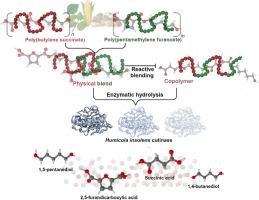聚丁二酸丁二烯/聚2,5-呋喃酸五亚甲基共混物及嵌段共聚物的酶解机理研究
IF 7.4
2区 化学
Q1 POLYMER SCIENCE
引用次数: 0
摘要
聚丁二酸丁二烯酯(PBS)和聚2,5-呋喃酸五亚甲基(PPeF)是生物基聚合物,经证明可用于衍生多功能共混物。由于它们的组合而产生的不同机械性能响应了食品包装的不同需求。虽然它们的物理共混已经使产品具有良好的柔韧性,但共聚物在保持良好的隔气性能的同时,还进一步提高了弹性。通过水解酶完全降解的可能性为这些聚合物的完全绿色潜力提供了额外的优势。这两种均聚物、它们的物理共混物和共聚物在孵育24小时后被Humicola inens角质酶(HiC)分解,失重率达到100%。PBS的水解速度比PPeF快,而有趣的是,当每种聚合物的含量为50%时,物理共混物比共聚物更容易被酶水解,这是由重量减轻和释放单体的HPLC定量得出的结果。凝胶渗透色谱分析表明,这种趋势与水解第一阶段分子量的减少更为明显。利用傅里叶变换红外光谱对聚合物在水解过程中的表面表征同样证实了PBS部分的水解速度更快。与物理共混物相比,核磁共振显示共聚物中水解相关基团的出现速度较慢。总的来说,这一机制研究表明,共混或合成共聚物可以影响酶水解,对酶的开发作为一种环保的新兴回收技术具有重要意义。本文章由计算机程序翻译,如有差异,请以英文原文为准。

Mechanistic study of enzymatic hydrolysis of poly(butylene succinate)/poly(pentamethylene 2,5-furanoate)-based blend and block copolymer
Poly(butylene succinate)(PBS) and poly(pentamethylene 2,5-furanoate)(PPeF) are bio-based polymers that proved to be compatible to derive versatile blends. The different mechanical properties resulting from their combinations respond to the diverse needs in food packaging. While already their physical blending lead to products with good flexibility, copolymers showed further improved elasticity while maintaining good gas barrier properties. The possibility of being fully degraded through hydrolytic enzymes places an additional advantage to the fully green potential of these polymers. The two homopolymers, their physical blend as well as copolymer were demonstrated to be decomposed by the Humicola insolens cutinase (HiC) reaching 100 % of weight loss after 24 h of incubation. PBS was hydrolysed faster than PPeF, while, interestingly, at 50 % content of each polymer, the physical blend was more susceptible to enzymatic hydrolysis than the copolymer, as resulted from weight loss and HPLC quantification of the released monomers. This trend was even more pronounced related to reduction of molecular weight during the first phase of hydrolysis as indicated by Gel Permeation Chromatography analysis. Surface characterization of the polymers during hydrolysis by using Fourier Transform Infrared Spectroscopy likewise confirmed faster hydrolysis of PBS moieties. Nuclear Magnetic Resonance highlighted slower appearance of hydrolysis-related groups in the copolymer when compared to the physical blend. Overall, this mechanistic study indicates that blending or synthetizing copolymers can influence enzymatic hydrolysis with important implications towards exploitation of enzymes as an environmentally benign emerging technology for recycling.
求助全文
通过发布文献求助,成功后即可免费获取论文全文。
去求助
来源期刊

Polymer Degradation and Stability
化学-高分子科学
CiteScore
10.10
自引率
10.20%
发文量
325
审稿时长
23 days
期刊介绍:
Polymer Degradation and Stability deals with the degradation reactions and their control which are a major preoccupation of practitioners of the many and diverse aspects of modern polymer technology.
Deteriorative reactions occur during processing, when polymers are subjected to heat, oxygen and mechanical stress, and during the useful life of the materials when oxygen and sunlight are the most important degradative agencies. In more specialised applications, degradation may be induced by high energy radiation, ozone, atmospheric pollutants, mechanical stress, biological action, hydrolysis and many other influences. The mechanisms of these reactions and stabilisation processes must be understood if the technology and application of polymers are to continue to advance. The reporting of investigations of this kind is therefore a major function of this journal.
However there are also new developments in polymer technology in which degradation processes find positive applications. For example, photodegradable plastics are now available, the recycling of polymeric products will become increasingly important, degradation and combustion studies are involved in the definition of the fire hazards which are associated with polymeric materials and the microelectronics industry is vitally dependent upon polymer degradation in the manufacture of its circuitry. Polymer properties may also be improved by processes like curing and grafting, the chemistry of which can be closely related to that which causes physical deterioration in other circumstances.
 求助内容:
求助内容: 应助结果提醒方式:
应助结果提醒方式:


